While trying to figure out what to do with about 75 pounds of fruit that our citrus trees bestowed upon us in January, we came across an interesting fact: marmalade is really easy to make. People of older generations may know this already, but so far as we knew, marmalade was one of those mysterious things that strictly comes from a jar. It turns out that all you need is citrus fruit, water, sugar and some time on the stovetop.
The first step is to peel the fruit. We’ve made lemon, lemon-orange, and orange marmalade, but you can use pretty much any citrus fruit.
We looked around a bit and settled on this recipe primarily because of its simplicity. It scales well. For a large batch, just keep peeling and cutting fruit until the pot is full or your hands were tired. You can also scale down–grab a couple of oranges from the cafeteria and you’ll make a lot of friends in your dorm kitchen.
The peels need to be cut into little slivers for the appropriate texture in the marmalade. If you stack up the pieces, you can cut a bunch at once.
Many recipes recommend removing the white pith because it is bitter. Other recipes recommend removing the pith and reserving it, cooking it along with the fruit in a cheesecloth bundle and removing it at the end, presumably to allow extraction of the pectin. Many jam and jelly recipes call for pectin to be added, but it isn’t needed for marmalade because of the amount of pectin already present in the skin and pith of the citrus fruit.
Some recipes call for a blanching or soaking stage. The primary purpose of blanching is to remove the bitterness from the pith and peel. We like bitter marmalade, so we left in most of the pith and didn’t soak or blanch the peels or fruit. That also keeps the recipe simple– just slice up the fruit and throw it in the pot with the peel pieces.
The fruit and peel are cooked in water until they’re good and soft. It takes a while (about an hour), but once you’ve got a nice simmer going, you can ignore it pretty well.
The sugar goes in. Lots of sugar. The original recipe calls for 4 cups of water and 4 cups of sugar (with ten lemons). The 4 cups of water barely covered the raw fruit (in a saucepan with roughly equal depth and diameter). For scaling the recipe up or down, you can use that as a rough guide: pour in water a cup at a time until the fruit is almost covered, then once everything’s soft add as much sugar as you did water.
Stir in the sugar, and bring it up to a boil, stirring regularly.
The original recipe says to cook it until it’s 220 degrees fahrenheit. If you’re one of the few with a well-calibrated thermometer, congratulations. For the rest of us, put a spoonful of the proto-marmalade on a cool plate. If it’s still runny after cooling for a minute, keep simmering a little longer. It should show signs of jelling after cooking for 45 minutes to an hour.
That’s it. You’ve made marmalade!
But now you’re wondering what to do with it. We recommend spreading it on a freshly toasted english muffin. Or maybe a crumpet.
You can put the rest of it in a bowl, let it cool, then keep it in the fridge and use it. Or you can can it. Canning is not as scary as it sounds. You pour the warm marmalade into warm jars, wipe the rims clean, put a clean lid and rim on them and boil the jars covered with water for 15 minutes.
There are lots of kinds of canning setups but the simplest is a pot with a spacer to keep the jars off the bottom. While you can get dedicated canning kettles with jar racks inexpensively, you don’t really need any special equipment. Rules of thumb: your pot needs to be deeper than your jars so you can cover them with water, and the jars shouldn’t rest on the bottom of the pot, so as to avoid thermal stress. You can put a small wire cooling rack, a vegetable steamer, or an array of skewers tied together in the pot to keep the jars off the bottom.
After boiling the jars, you can ladle out some of the water and lift your jars out with an oven mitt. However, a set of jar lifting tongs doesn’t cost much and makes that step easier. A wide mouthed funnel is nice since it keeps stuff of the rims of the jars, but is also not necessary, especially if you get wide mouthed jars.
The folks who make Ball jars have some nice overviews (pdf) of canning techniques.
You may recognize our technique as one common in mathematics. We have reduced a difficult problem (what to do with 75 pounds of citrus) into a problem whose solution is well known: what to do with many jars of marmalade. QED.




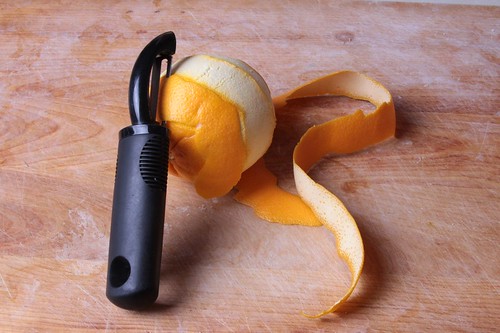


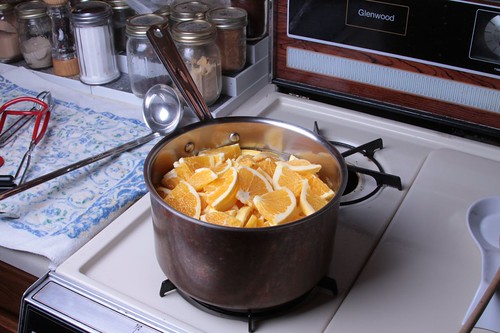
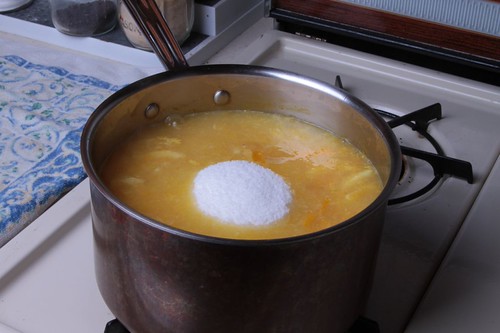
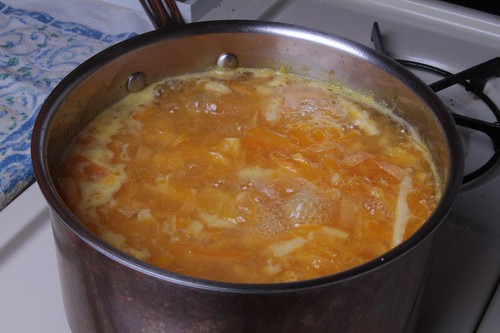

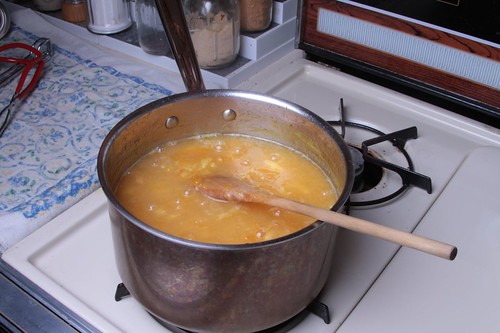

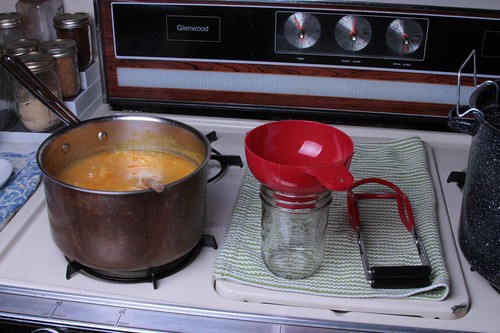
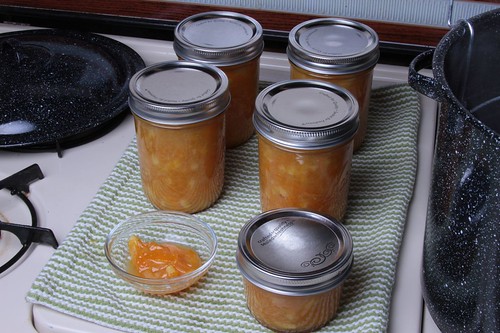
oooo yes.. Marmalade is one of the easiest things to make.
I’ve made.
Sour Apple
Orange and Lime
Butternut Squash and Chilli
Lemon
Cinnamon and Ginger
All very nice!
A couple of tips that I find useful.
As already stated, boil the jars once they have been filled but don’t tighten the lids until you take them out of the pan.
This steralises the jars and when the jars cool down, creates an hermetic seal (air tight seal which stops bacteria breeding hence the "pop" when you open jars).
If you have a breadmaker, most of them these days have a "Jam" setting. Put all the ingredients in the breadmaker and set the Jam setting going, leave it until its finished and you have perfect Jam/Marmalade.
If you don’t have a breadmaker, a slow cooker works well too on a low setting, this doesn’t only cook the fruit but infuses the oils and vitamins from the fruit into the mixture giving it a bolder taste.
Good luck and remember.. don’t lick the spoon after you’ve stirred the mixture.. its HOT! :)
I’ve been waiting for this! Looks like fun… I’ll have to do this as my next lemon project :)
dot
I have made marmalade and jams for years, and never once boiled the jars in water to sterilize them.
The easy way is, until your jam is ready, clean your jars and lids thoroughly and leave them in very hot water. When the marmalade is done, get a jar out of water, dry it quickly with a clean cloth (it should be so hot that it dries by itself), pour the hot jam/marmalade using a ladle and a funnel, tightly screw a lid over the jar, and place it UPSIDE-DOWN on a towel.
The temperature of the jam will kill the bacteria/fungus in the jar and on the lid.
I recommend using gloves, the potential for burns with hot sugar is not negligible.
After half an hour, when it has somewhat cooled, turn the jars over. You should hear a pop after an hour or so, when the metal lids cave in as the air inside the jar cools and the pressure drops. A jar that has not ‘popped’ is probably leaky.
I never had any problem in years, except for the occasional leaky lid that let fungus into the jar, but that’s what happens when you reuse lids too many times.
Lemon marmalade made with fresh lemons (just the juice and some rinds) is my favourite.
Have fun.
Philippe
I agree with Anonymous, easier to boil the jars ahead of time.
What I’ve also started doing in the past couple of years is to load the dishwasher full with jars (I usually make a large amount of jam at a time) and let it run. The dishwasher is hot enough to sterilize them and I get them all done in one go. (Much simpler than sterilizing 60 jars in a pot that holds four :)
Speaking of Quince, that is one of the most unusual tasting and smelling jams ever. And the fact that it turns pink is amazing. If you ever get a chance …
Any preserved food with a high dose of either sugar (jams) or salt (pickes) will stay good for a very long time without sterilization.
The reason? Osmetic pressure will blow up the bacteria as they try to balance their sugar or salt concentration with your preserve.
Sterilization is ultra important with non salty or sugary preserves, like spaghetti sauce, vegetables and such, but don’t go crazy on jams.
YAY!!! Lemon marmalade here I come! I know I’m a philistine, but I like to use only the peel that practically disintegrates when I remove the flesh after simmering the whole lemons a couple hours and let sit for hours–a day or 2 even. I put all the rest of the peel into muslin, which I remove from the pot only after the marmalade has jelled. I’ve chopped that peel to dry and sugar for candied peel. The base recipe is from Jules Clancy at STONESOUP.com–it’s even a bit easier than the evil scientist’s recipe–if anyone can believe that. Of course, Jules chops all the peel, as she, like all of you treasures that bitterness. The reason I know about putting most of the peel into muslin is Jules says to do so of you want a clear marmalade. A special thanks to Phillipe for the bit about placing the filled jars upside down to help seal the lids. And, of course, thanks to the Evil Scientist for starting this whole blog!!
Sue
OK, now I’m really craving marmalade. This recipe is wonderful for those who had to pick all their citrus fruits in a hurry before they ruined, but then there are the rest of us who saw the temperatures in Florida and thought about how the price of oranges is going to skyrocket immediately!
When you’ve made jam a few times, you can just look at the way the stuff drips off a spoon to tell when it’s done. I’ve made just about every kind of preserves EXCEPT marmalade. It’s obvious I don’t live in a tropical state.
so that’s where discarded candyfab sculptures find their rest?
Well, we do happen to have a lot of sugar on hand.
Another improvised spacer for jars is the rings for the lids. (Rings are relatively cheap, so you might buy an extra package for this.) Just make sure the jars are sitting on the rings, not inside them. You could even lay the skewers on top of the rings.
What is the difference between marmalade and jam?
Marmalade is usually made with rind included, is usually bitter, and is usually made from citrus fruits. The word comes from the word for quince in many romance languages. Jam can be made from just about any fruit pulp and is usually sweeter. Jelly is usually made from fruit juice or strained fruit.
Just a correction, marmalade comes from the Portuguese word for quince, other romance languages use similar forms of quince like coing (fr), cotogna (it), only the Spanish come close membrillo (es).
In Portuguese quince is "Marmelo" hence the word "marmelada". In Portuguese the distinction between jam ("compota") and marmalade is easy: marmalade of quince (or other fruits) must include the cooked pulp, in jam the pulp is filtered and only the fruit gelatine and cooked juice are poured into the vase.
… and of course in languages like german, marmalade simply means jam. Any sort of jam.
(Though I admit I am a purist and only use the word marmalade for Seville orange marmalade myself :)
Yum… now I’m eyeing those oranges on my Valencia. Not quite ripe, but soon.
A word of caution, though, to people using store-bought oranges. Most are coated with wax/fungicide to prolong shelf life… eating a little bit from it rubbing of on your hands won’t do any harm, but I wonder about the effects of concentrating it when you make marmalade.
Waxed fruit should be scrubbed beforehand with a brush or abrasive pad to remove the waxy preservative.
Produce bought from grocery stores is coated in food grade wax, if at all. So the wax won’t do you any harm, but it will come off the peels while boiling. Yuck. I wash all fruits and veges with dish soap and really hot water. Not p.c. but, hey, it works on my dishes and they haven’t killed me yet. :)
We just discovered a great way to use up that Marmalade. Toast some pumpernickel bread and heavily butter one slice per sandwich. Liberally apply marmalade to both pieces, add some well cooked but not too crispy thick cut bacon, close up and enjoy.
Another thing to do with an excess of citrus is candied peel. I’ve done lemon and orange. It’s a little time consuming but not too bad. Next time I’m going to dip them in dark chocolate and see if I can compete with Frango.
Great job at simplifying a recipe to its essence. Made some today, but must have overcooked it. It’s more rubbery than gel-y. Still tasty. Hopefully the next one will be better.
Try using a lemon in with the oranges to increase the acidity and get a better set. Too little acidity results in a poor set and you end up over-boiling which gets rid of some of the water, hence the rubbery finish.
The way we do it is to wash the jars and rince them in hot water, then put them in the oven upside down and turn to 100 celcius. The lids and rings are then put in a small pot of water and boiled from 5min before needed until they are all gone.
Never had a jar go wrong this way yet…
Being even lazier, I wonder if I can just chuck a bunch of questionable fruit (starting to get a bit soft on the outside) into the food processor as the first step, if I’m less worried about having a chunky texture…
Don’t see why not. You’ll probably get more of a jam texture. You’ll want to remove any seeds before processing, though.
Tried it with some mandaran oranges we had left over from parties, that weren’t likely to survive long enough to get eaten at the rate we eat them when there isn’t a party. It seems to work pretty well; got favorable comment from the wife "this isn’t so bad; it doesn’t have those big chunks of peel that I don’t like." ! It didn’t get as clear as yours, since the pith and juice were pretty blended together. Less pith and no seeds in the mandarans, either… Overall I rate it as a success!
The fruit should be in tip top condition or you will get a poor flavour and poor set and the product won’t keep.
Everything looks fine and home-made marmalade tastes much better than any commercial product you can buy.
Just a quick comment from here in Britain – if you are using normal "eating" oranges, then you are not actually making marmalade, you are making orange jam.
Authentic English marmalade has to be made with Seville oranges, which are so bitter that they are uneatable – only this can give you the proper bitter taste.
Phil
Similar to the word robot, the word marmalade has both specific and general uses. The term marmalade is generally used for any bitter jam with rind in it, especially if it is made from citrus. Seville orange marmalade is, of course, the quintessential marmalade, and is what most folks think of when they hear the word. But, especially given that the word marmalade comes from the word for quince, I’m going to have to disagree that it is the only marmalade. And now that I’ve made it, I have a distinct fondness for lemon marmalade. Mmmm…
Do the seville oranges also make the marmalade darker? My British husband is particular about his marmalade (imagine that!) and insists it be dark and chunky. It’s obvious from this recipe how to get the chunky bit solved. What about the dark?
This is a complete guess, but I wonder if brown sugar would give that darker colour?
I wouldn’t think Brown Sugar. Though known in Britain it’s no so widespread in use as in N.America. Perhaps cooking it longer ’til it starts to caramelize?
brown sugar and seville oranges is called old fashioned marmalade here in the UK
I have not made marmalade with Seville oranges, so I don’t know about their particular color. (My trees make Meyer lemons and navel oranges, so that’s what I use.)
The longer you cook the marmalade, the deeper the sugar caramelizes, darkening it. It also gets thicker and chewier. Some recipes I have seen warn against this and call it "overcooking". I think it adds interesting flavor notes and texture, but be warned that some folks think it is undesirable.
Dark marmalade can be made by using half white sugar, half demarara sugar and a couple of tablespoons of black treacle. Don’t try to caramelize as suggested by someone else, You will end up with a poor result.
I don’t agree – you can get a very good flavour by caramelizing marmalade. But it’s a caramel flavour.
Seville orange marmalade has the same colour as any other orange jam. It starts light and fresh-tasting, and as it cooks it caramelizes and darkens.
By the way it seems a lengthy process to pare the orange peel. The usual method is either to juice the oranges and slice the remaining peel, or cook them whole then slice the peel, reserving the pulp.
I would suggest one ounce of black strap molasses to a batch (4 to 6 cups), while simmering may do the trick.
Seville oranges are impossible to find in some areas, including where I live. I’ve tried and even specialty grocers don’t have them.
You might try mail order. There are lots of companies that specialize in shipping fruit.
What’s the shelf life once it’s canned? It’s cold now in Illinois, but in the spring/summer the farmers market opens up again.
This is our first attempt, so I don’t have any hard data of my own. The rule of thumb with my mom’s jam when I was growing up was that last year’s jam had to be eaten before this year’s could be opened. I think in general that home canned jams are best in the first year and usually last a year or two.
AFAIK, as long as it’s potted up properly into sterilised jars, it should last practically indefinitely.
I’ve recently been enjoying a jar that my Mum made back in Feb 2000, it’s survived two house moves and a minor earthquake … Found at the back of the cupboard last October, still in perfect condition.
Once we clear our remaining stocks out I’m tempted to give this a go :-)
A similar note on canning. My family makes strawberry jam each year and can it so we have enough to last us until the next summer. I’d never seen jars sealed shut by boiling them before — we boil our jars to clean them only. We leave maybe a half inch of room from the top of the jar and then pour in melted paraffin wax after the jam has hardened a bit. The lids go on after the wax has solidified.
We’ve never had a problem with mold in jams.
Actually I have seen the wax topped jams go bad with mold. My mother used to make blackberry jam from the bushes growing wild all around our neighborhood and sometimes this would happen. If you don’t get a perfect seal with the wax that seems to cause the problem.
Grapefruit marmelade is nice and bitter. First eat your grapefruit and keep skins in fridge till you have enough. I usually use 2 or 3. Cut them up with one lemon and put in pressure cooker. cover with water and pinch of bicarbonate of soda. Cook on high for 10 mins and then proceed as normal adding the same volume of sugar to the fruit.
Off on a tangent, I grew up in Montana, so not many oranges, but in the 80’s a few scammy fruit dealers started coming through with pickup loads of citrus and selling them by the case for about 2x or 3x market (I think they bought them regionally from Grocery suppliers) and my Ex and I made a whole bunch of different canned citrus "things" including marmalades, candied peels and such.
Anyhow to the point – I wanted to recommend that you tried tomato conserves, while your rendering down the candyfab cast-offs :-) its a slightly unusual jelly and has a great taste
This is the side of EVIL MAD Scientists most people don’t see. there is clearly more to life than sewing cat brains into killer robots, as you can see…
As a former editor, I must say: Damn that is beautiful recipe writing.
The lemon marmalade tastes amazing, too. I happen to like it on curried soy patties, not that I’m a chutney person. Would dark sugar would be good in this? This link suggests it is: http://www.newstatesman.com/200301270044 Of course, being daily wowed by your recipe, I’m more interested in your opinion.
I’m also curious if you made lemon chutney too [ such as http://localfoods.about.com/od/winter/r/lemonchutney.htm ] or whether you’re just adding a few spices and cooking savories in your marmelade like I am.
Your fan, White Fang
I don’t boil my jars after filling them. I put the clean jars in the oven for 15 minutes or so before bottling my marmalade, then put the lids on whilst still hot so you get a good seal. Job done.
Another well known method for boiling (both marmelades and/or bottled tomato) used around Italy consists in "paving" the pan with one or more kitchen towels (as many as strictly necessary) when the water is inside, then carefully put one bottle at the time, and when ready tie them up on the upside.
Also, the important things about bottling/jarring is not only sterilizing (as I’ve read in the comments), but making sure that the air is well gone from the bottle/jar itself, so the content will stay safe for a much longer time.
My 5 cents :)
I think I will make marmalade this weekend! yum!
One of my favorite canning blogs is Food in Jars: http://bit.ly/20GHYy
Also Tigress in a Jam: http://bit.ly/1htZOu
There are some troublesome remainders in your equation. Can you help clean up the products?
Oh my god. I just tried this today using your guidelines and it came out great. I had a bunch of citrus that was going dry so I cut it up for this. 3 small lemons, 2 blood oranges, 2 tiny tangerines, 2 Valencia oranges, and a 1" piece of ginger. Made 2 jars of marmalade. The ginger just takes it into heavenly. I will be doing this again.
I’ve been getting into my marmalades recently. Batch five is cooling right now. Further to ‘ginger takes it to the heavenly level’, try throwing in half a used vanilla pod for the cooking time. Whatever seeds are left will permeate through the marmalade giving a magnificent smell and taste. I should be charging for this advice.
Feel free to send some of your 75 lbs. of marmalade my way! I’m one of the few people in my universe who likes it. In fact … I might be the only person in my universe who likes it. Oh well. Thanks for sharing!
I just want to say thanks for posting this. Because of my success with your marmalade instructions, I’m doing all sorts of preserving now; so far I’ve made two kinds of preserved lemons, orange, lemon and lime marmalade, plum/orange/cardamom, and plum/orange/cinnamon/coriander/habañero/NM red chile jams and now I’m going to follow your plum chutney recipe. Yay!
Where is the quince? Gotta be kidding…
I’m thinking of making marmalade tomorrow after reading your recipe and suggestions. D I need to peel the rind or could I just cut the whole lemon and rind at a go. Thanks for your useful tips.
Colleen from Malta
Curious about your question of eliminating the rind-peeling step, and just cutting up the fruit whole. I didn’t see anyone answer it in the included messages. Did you get an answer? If so, can you forward it? Or perhaps by now you have tried it; if so, how did it turn out. Thanx for any info.
I decided to give it a try. Used a motorized food slicer set at 1/8" thickness. Discarded the first and last slices which were all pith/rind. Cut slices in quarters. Cooked one hour, added sugar cooked another 1&1/2 hours. Came out perfect.
Ever since I made this recipe last summer, I’ve simply cut my oranges into quarters, unpeeled, and slice them very thinly. That’s it. Turns out wonderful. I don’t see the point of separating the rind from the pith if you’re not removing any of the pith. The fruit segments naturally separate from the peel as they cook in any case… Seville oranges, the original fruit used in British marmelades, were so bitter you HAD to remove much of the pith and go through the boiling steps to get an edible product. Valencias and other eating oranges we typically use today are so sweet you actually need the pith or it wouldn’t have any of the characteristic bitterness that is part and parcel of a good marmelade. What’s more, WITH the pith, Valencia or Blood orange marmelade is every bit as good as those "traditional" Seville marmelades we grew up on. And a piece of cake to make. Fresh citrus fruit, not variety is the key.
Oh yumm! I must say every French recipe I’ve seen uses equal weight of fruit and sugar, no relation at all between water and sugar. You may adjust the sugar down from that of course, starting with a bit less and tasting as you add more till you have what you like.
Where I live, I can’t even get a citrus fruit tree to sprout, so I’ll have to settle for store-bought fruits. However, the waxy layer needs to be removed before I make the marmalade.
Any suggestions to do this? What I’ve come up with is simply dip the fruits in boiling water quickly, and remove the wax that comes up on top. Any other suggestions would be helpful, thanks!
I have tons of "sour oranges", i.e. ornamentals, found your recipe, started to peel and cut…what about the massive amount of seeds in the oranges, I imagine I would need to remove them all first??? Didn’t see any other posts with this concern, am I the only one with seedy oranges???
Thanks,
Lorna
Yes, separating out most of the seeds is a good idea. I pull most of my seeds out when cutting up the fruit. An easier alternative might be to juice the fruit first, separating the seeds at that point. Then cut up the juiced fruit to use in the marmalade with the juice.
Looks awesome. I don’t really like the flavor you’ve done, but some of the others sound interested.
I’ve always wanted to can stuff, but the whole thing about how long to can always scares me. High acidity, low acidity, etc. I just don’t want to screw it up and have a bunch of bad jars I can’t give to anyone.
This looks great and I love the photo’s to guide the way! I am looking to order and have shipped to Illinois, enough oranges to make 150 to 200 jelly jars or possibly half pints. Any suggesions on how many oranges I might need?
I’ve only made small batches from fruit I had on hand, so I don’t know how it would scale up.
Has anyone tried less sugar? I normally purchase "low sugar" marmalade and prefer that to regular marmalade. Will there be enough pectin to jell even if there is less sugar? Thanks for the recipe. This is great!
I haven’t tried less sugar, but it ought to be fine to reduce the amount significantly. There is an amazing amount of pectin in the pith.
You can also use Splenda, it works great and tastes great. This is one of the best recipes I have every used and I have used alot.
You’re a scientist right? The setting point is a balance between pectin, sugar concentration and acid. If you reduce the starting sugar concentration, you’ll have to boil the jam down longer to reach the setting point – which – all other things being equal – will be at the same sugar concentration.
To get a lower sugar concentration to set, there is a type of pectin used in low-sugar jams which you could add. Higher acidity – lemon juice, up to say 10% of liquid – will also help reach a set.
Otherwise, settle for fresh and tasty but runny marmalade.
I made this with seedless mineolas, it was absolutely wonderful. The only thing I did different, I hadn’t seen your recipe before I started, was I cut my oranges in quarters, and slivered them, rind and pulp together, as thin as I could. You couldn’t tell, the pulp disappears from the rind slivers. Cuts out one step. I made lemon-lime today, hope it’s as good as the orange.
Thank you for your easy instructions and pictures. It helps alot.
It’s a sad day when an Evil Mad Scientist can’t lay his hands on a thermometer! Surely you could borrow one from the baths of boiling acid or something for a few minutes.
However, marmalade is wonderful and so I guess it’s excusable ;-)
We are amongst the fortunate few with well-calibrated thermometers; your accusations are unfounded. However, when we do try to write recipes (and other instruction sets) in ways that do not require specialized tools when they are not absolutely needed.
Windell H. Oskay
drwho(at)evilmadscientist.com
http://www.evilmadscientist.com/
I hope you understood that I was teasing you there, but your use of "the rest of us" clearly implied that you didn’t have one!
I realise that you make these accessible as possible. It was not a criticism.
Please accept apologies if it appeared so.
hi i have been looking everywhere for just a good, normal and simple recipe yours is perfect lol it even has pictures and that is really good for me considering my thinking capacity haha.
Thank you so much for having a good site ta xx
You have a nice and simple way to get sugar:water:fruit ratios. I don’t peel the oranges. Instead I thinly slice the whole fruit, then I go cross-way with the knife. I work on a wooden cutting board that has a recessed area — to catch all the juice. Also, I have found that bringing the fruit and water to a boil, then letting it sit covered overnight before proceeding makes the peels more tender. Did you mention that this should be cooked in a stainless steel or porcelain pot? I’m glad I found your recipe because it resonates with me. I usually use the recipe in the Settlement Cookbook but, alas, it’s packed away because I just moved 3000 miles. Thank you for this because I needed to cook to help me feel at home in a new place.
I have never done marmalade but my tree is full and might try it now since I’ve found this recepie. What happens to the seeds do they disintegrate while cooking. Do they have to be special oranges as mine are good for eating but a bit on the sour side.
The seeds can be taken out or left in at your preference. I like to take them out. Any citrus fruit will work. I usually use lemons.
Just read through the thread for the last 2 years and wanted to comment on a few points! I live in UK and have been making marmalade in a pressure cooker for over 20 years. I just cut the seville oranges in half and throw them in. After 15 mins or so and when pressure is down take out all the peel. Wizz that in a food processer to the desired size. Boil pips and flesh for a bit then scoop off the pips. Any missed ones come to the top after the sugar is added. The essential method is the same. As for the brown sugar, we have many types available in UK, light, dark, muscovado, demerera and all these FairTraid. But I’m certain that dark marmalade is made by longer boiling. Then its called Traditional, Old fashioned and even Dundee. Just come across a recipe for Seville gin so off to try that!!
Regarding sour oranges, the traditional orange for marmalade is the "Seville" orange which is beyond sour, all the way to bitter: http://en.wikipedia.org/wiki/Bitter_orange
The only possible issue with your sour oranges is that you might need more sugar. Somehow, I doubt it thou’.